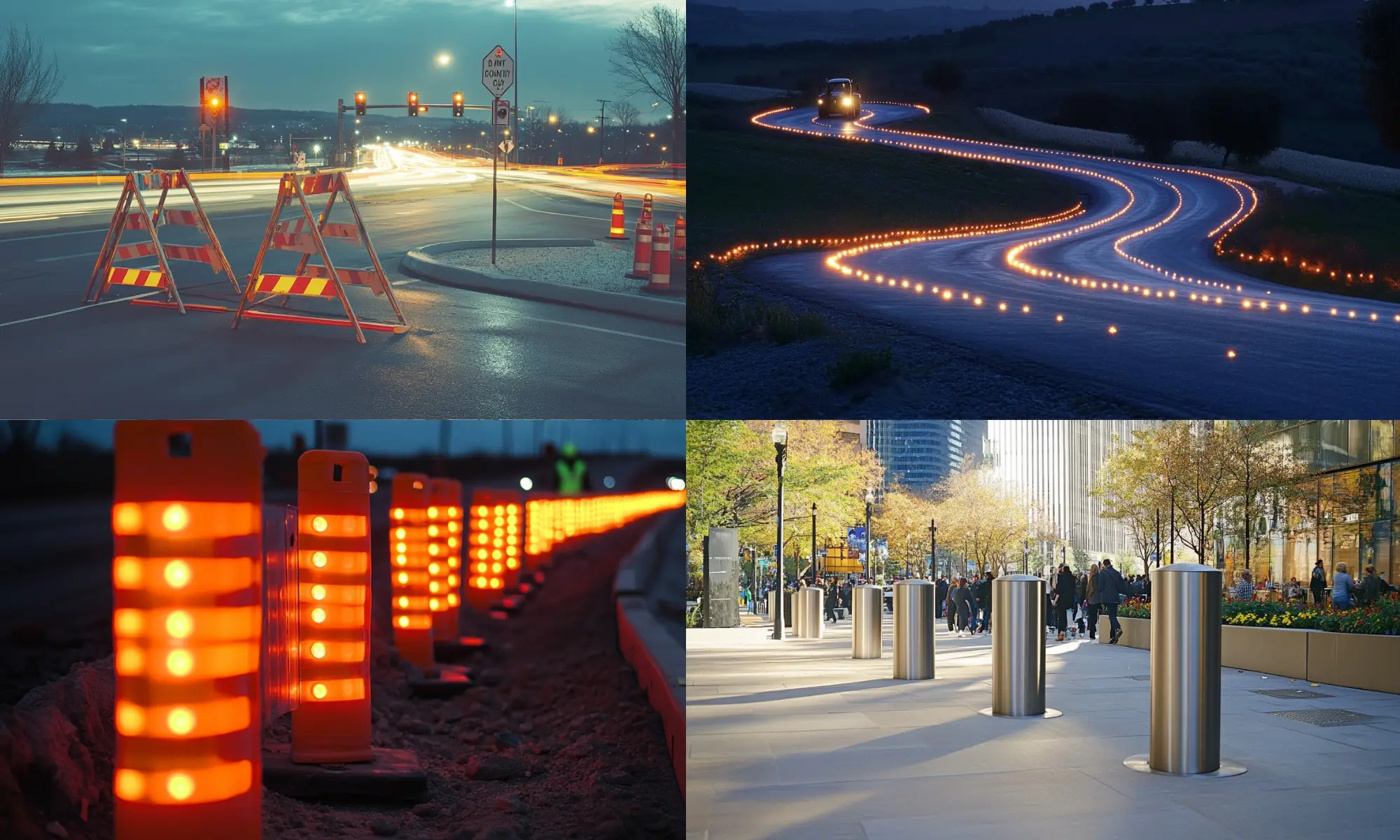Ensuring the safety of motorists, pedestrians, and workers on roadways is paramount. Traffic safety equipment is critical in managing traffic flow, preventing accidents, and safeguarding lives. This comprehensive guide delves into 25 different types of traffic safety equipment, exploring their functionalities, applications, and significance in modern transportation systems.
Whether you’re a traffic management professional, a construction supervisor, or simply an informed citizen, understanding these tools can contribute to safer roads for everyone.
25 Different Types Of Traffic Safety Equipment
Ensuring the safety of motorists, pedestrians, and workers on roadways is a complex challenge. Traffic safety equipment is essential for managing traffic flow, reducing hazards, and preventing accidents. Let’s explore 25 important types of traffic safety equipment, detailing their functions, applications, and significance in maintaining roadway safety.
1. Traffic Cones

Traffic cones are bright, cone-shaped markers made from durable plastic, typically colored in high-visibility hues like orange or fluorescent yellow. They come in various sizes and often feature reflective strips to enhance visibility during low-light conditions.
Usage
Traffic cones are versatile tools used to:
- Direct Traffic: Guide vehicles around construction zones, accidents, or other temporary roadblocks.
- Mark Hazards: Indicate road surface irregularities, debris, or other potential dangers.
- Create Boundaries: Define safe zones for pedestrians or segregate lanes during events.
Benefits
- High Visibility: Their bright colors and reflective materials make them easily noticeable.
- Portability: Lightweight and easy to transport, cones can be swiftly deployed and repositioned as needed.
- Cost-Effective: Reusable and affordable, making them a staple in traffic management.
Standards and Specifications
Manufacturers adhere to standards such as ANSI/ISEA Z138.1 for safety colors and reflectivity to ensure cones meet visibility requirements.
2. Barricades

Barricades are sturdy physical barriers designed to block or redirect traffic. They come in various forms, including A-frame barricades and vertical and horizontal Type I, II, and III barricades, each suited for specific scenarios.
Usage
- Road Construction: Secure construction zones by preventing unauthorized vehicle access.
- Event Management: Control traffic flow during parades, sports events, or public gatherings.
- Emergency Situations: Isolate accident sites or hazardous areas to ensure safety.
Benefits
- Durability: Made from robust materials like steel or heavy-duty plastic, barricades withstand harsh conditions.
- Reusability: Designed for multiple uses, reducing long-term costs.
- Visibility: Often equipped with reflective surfaces and bright colors for enhanced nighttime visibility.
Types of Barricades
- A-Frame Barricades: Portable and easily set up, ideal for temporary traffic control.
- Vertical Barricades: Fixed barriers used for more permanent traffic redirection.
- Horizontal Barricades: Span across roads to block lanes entirely.
3. Delineator Posts

Delineator posts are slender, flexible markers, usually made from plastic or rubber, equipped with reflective elements. They are designed to guide traffic and mark boundaries.
Usage
- Lane Division: Separate lanes on highways and expressways.
- Roadside Marking: Define road edges and prevent vehicles from veering off.
- Hazard Indication: Highlight areas with potential dangers like sharp curves or slopes.
Benefits
- Flexibility: Resistant to high winds and impact, minimizing damage.
- Visibility: Reflective surfaces ensure they are seen in adverse weather and nighttime conditions.
- Ease of Installation: Simple to place without specialized equipment.
Installation Standards
Guidelines such as the Manual on Uniform Traffic Control Devices (MUTCD) provide specifications for placement and spacing to maximize effectiveness.
4. Traffic Signs

Traffic signs are standardized symbols placed along roadways to convey information, warnings, or regulations to drivers and pedestrians. Common types include stop signs, yield signs, and speed limit signs.
Usage
- Regulatory Signs: Inform drivers of laws and regulations (e.g., speed limits, no entry).
- Warning Signs: Alert drivers to potential hazards ahead (e.g., sharp turns, pedestrian crossings).
- Informational Signs: Provide guidance and information (e.g., distance markers, route numbers).
Benefits
- Standardization: Universally recognized symbols ensure consistent understanding across different regions.
- Safety Enhancement: Provide critical information that helps prevent accidents and guide safe driving behavior.
- Versatility: Applicable in various settings, from urban streets to rural highways.
Design and Compliance
Traffic signs adhere to standards set by organizations like the Federal Highway Administration (FHWA) to ensure clarity, consistency, and visibility.
5. Traffic Signals

Traffic signals are electronic light systems installed at intersections and pedestrian crossings to control the movement of vehicles and pedestrians. They typically include red, yellow, and green lights.
Usage
- Intersection Control: Manage the flow of traffic to prevent collisions and ensure orderly movement.
- Pedestrian Crossing: Provide safe intervals for pedestrians to cross streets.
- Traffic Flow Management: Regulate traffic during peak hours to reduce congestion.
Benefits
- Accident Reduction: Controlled movement minimizes the risk of head-on and side-impact collisions.
- Efficiency: Streamlined traffic flow reduces delays and improves travel times.
- Adaptability: Modern signals can adjust timings based on real-time traffic conditions.
Advanced Features
- Adaptive Traffic Control Systems (ATCS): Use sensors and algorithms to optimize signal timings dynamically.
- Countdown Timers: Inform drivers and pedestrians of the remaining time to cross or proceed.
6. Speed Bumps and Humps

Speed bumps and speed humps are raised sections of road designed to slow down vehicular traffic. While both serve similar purposes, speed humps are typically broader and more gradual than speed bumps.
Usage
- Residential Areas: Reduce vehicle speeds to protect pedestrians and children.
- School Zones: Ensure safety around areas with high pedestrian activity.
- Parking Lots: Control vehicle speeds in areas with frequent stops and movements.
Benefits
- Speed Control: Effectively reduces vehicle speeds, lowering the risk of accidents.
- Noise Generation: Creates a tactile and auditory signal for drivers to slow down.
- Cost-Effective: Simple installation with minimal maintenance requirements.
Design Considerations
Proper design ensures that speed bumps and humps effectively slow traffic without causing excessive discomfort or vehicle damage. Standards often specify dimensions based on the desired speed reduction and road type.
7. Road Studs (Cat’s Eyes)

Road studs, commonly known as cat’s eyes, are reflective markers embedded in the road surface. They are designed to delineate lanes, edges, and other road features, enhancing visibility during nighttime and adverse weather conditions.
Usage
- Lane Marking: Clearly define lane boundaries on highways and rural roads.
- Edge Detection: Indicate road edges to prevent vehicles from veering off.
- Hazard Indication: Highlight curves, intersections, and other critical points.
Benefits
- Low Maintenance: Embedded directly into the road, reducing the need for frequent replacement.
- Durability: Resistant to harsh weather and heavy traffic.
- Energy Efficiency: Utilize ambient light and minimal power sources, making them cost-effective.
Types of Road Studs
- Static Studs: Provide constant visibility.
- Dynamic Studs: Enhance visibility during specific conditions, such as rain or fog.
8. Reflective Tape

Reflective tape is an adhesive material applied to various surfaces to enhance visibility. It is highly reflective, allowing it to be seen clearly under headlights and in low-light conditions.
Usage
- Vehicle Marking: Applied to the edges of trucks, buses, and other vehicles to increase visibility.
- Barrier Enhancement: Enhances the visibility of barricades, cones, and other traffic control devices.
- Signage Improvement: Used on signs to ensure they are noticeable at night.
Benefits
- Enhanced Visibility: Reflects light back to its source, making marked objects easily visible.
- Versatility: Can be applied to a wide range of surfaces and materials.
- Durability: Resistant to weather, UV rays, and abrasion.
Application Tips
For maximum effectiveness, reflective tape should be placed where it can catch the most light and maintained to ensure cleanliness and reflectivity.
9. Traffic Barrels and Drums
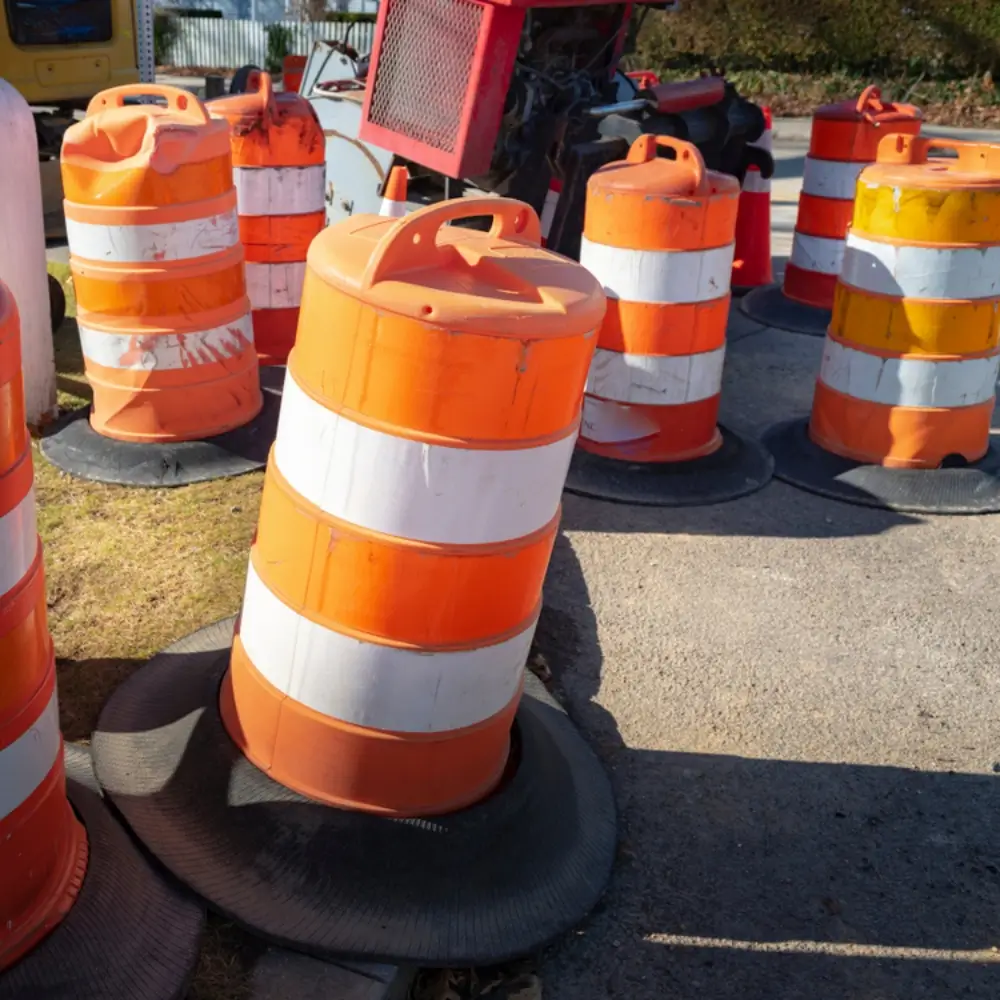
Traffic barrels and drums are large, cylindrical containers, typically colored bright orange, used to channel traffic and indicate construction zones or other temporary traffic control areas.
Usage
- Construction Sites: Direct traffic safely around work zones.
- Accident Scenes: Guide vehicles away from the incident area.
- Public Events: Manage traffic flow during large gatherings or parades.
Benefits
- High Visibility: Their size and color make them easily noticeable to drivers.
- Durability: Built to withstand impacts and harsh weather conditions.
- Reusability: Designed for multiple deployments, offering long-term utility.
Security Features
Many traffic barrels have internal weighting systems to prevent tipping and ensure stability in high winds or heavy traffic.
10. Bollards

Bollards are sturdy, short vertical posts designed to prevent vehicle access to certain areas while allowing pedestrian movement. They are often made from materials like steel, concrete, or plastic.
Usage
- Pedestrian Zones: Protect sidewalks and pedestrian-only areas from vehicle intrusion.
- Public Buildings: Secure entrances to museums, government buildings, and other important structures.
- Parking Areas: Designate parking spaces and prevent unauthorized vehicle entry.
Benefits
- Security Enhancement: Deters vehicle-based attacks and unauthorized access.
- Aesthetic Versatility: Available in various designs and finishes to complement urban environments.
- Flexibility: Can be fixed or removable, allowing for temporary security measures.
Design Considerations
Bollards should be strategically placed to balance security needs with accessibility, ensuring they do not impede pedestrian traffic.
11. Crash Cushions

Crash cushions are energy-absorbing devices installed in front of fixed objects like highway barriers, bridge supports, and bridge piers. They are designed to reduce the severity of vehicle impacts during collisions.
Usage
- Highway Safety: Protect drivers from striking fixed objects at high speeds.
- Bridge Safety: Absorb impact energy to prevent catastrophic failures.
- Construction Zones: Mitigate the effects of accidental collisions with temporary structures.
Benefits
- Impact Mitigation: Significantly reduce vehicle damage and occupant injuries.
- Cost Savings: Lower the costs associated with severe accidents and infrastructure damage.
- Compliance: Meet safety regulations and standards for roadside safety.
Types of Crash Cushions
- Spherical Cushions: Suitable for round or slightly curved objects.
- Rectangular Cushions: Designed for square or flat objects.
- Horizontal Cushions: Ideal for areas where vehicles approach from multiple directions.
12. Guardrails

Guardrails are barriers installed along road edges, medians, and bridges to prevent vehicles from veering off the roadway. They are typically made from steel and feature a w-shape to absorb impact energy.
Usage
- Highway Safety: Protect drivers from falling off steep drops or into hazardous areas.
- Bridge Protection: Safeguard vehicles from striking bridge supports or structures.
- Median Separation: Prevent crossover accidents by separating opposing traffic flows.
Benefits
- Enhanced Safety: Redirects vehicles back onto the road, reducing the likelihood of severe accidents.
- Durability: Resistant to weather and impact, ensuring long-term effectiveness.
- Maintenance Reduction: Requires minimal upkeep compared to other barrier systems.
Installation Standards
To ensure consistent performance, guardrails must comply with standards such as the AASHTO (American Association of State Highway and Transportation Officials) specifications.
13. Warning Lights

Warning lights are flashing or steady lights that alert drivers to hazards, changes in road conditions, or upcoming traffic controls. They are often mounted on poles or vehicles.
Usage
- Construction Zones: Signal workers and alert drivers to reduced speed limits or lane closures.
- Emergency Situations: Indicate accidents, road debris, or other immediate dangers.
- Weather Alerts: Warn drivers of adverse conditions like fog, ice, or heavy rain.
Benefits
- Immediate Alerting: Quickly captures driver’s attention to prompt cautious behavior.
- Versatility: Applicable in various scenarios, enhancing overall road safety.
- Nighttime Effectiveness: High visibility during darkness and low-light conditions.
Technological Advancements
Modern warning lights may incorporate LED technology for increased brightness and energy efficiency and programmable features for dynamic signaling.
14. Pavement Markings

Pavement markings are lines, symbols, and indicators painted or embedded into the road surface to guide traffic and communicate regulations. Common types include lane dividers, crosswalks, arrows, and symbols.
Usage
- Lane Guidance: Define and separate traffic lanes to organize vehicle flow.
- Pedestrian Safety: Mark crosswalks and pedestrian zones.
- Directional Indicators: Guide drivers on turning, merging, and exiting routes.
Benefits
- Clarity: Provide clear visual guidance to drivers, reducing confusion and errors.
- Flexibility: Easily updated or changed to accommodate evolving traffic patterns.
- Cost-Effective: Relatively inexpensive compared to other traffic control measures.
Standards and Materials
Pavement markings adhere to standards like the MUTCD, ensuring consistency in design and application. For durability, materials may include thermoplastic paints, epoxy coatings, or preformed tapes.
15. Channelizers

Channelizers are devices used to guide traffic through temporary lanes or around obstacles. They include cones, barrels, and delineators, often arranged in specific patterns to create temporary traffic channels.
Usage
- Road Construction: Direct vehicles around work zones and manage lane closures.
- Special Events: Control traffic flow during concerts, sports events, or parades.
- Emergency Responses: Guide traffic away from disaster areas or blocked routes.
Benefits
- Flexibility: Can be quickly arranged and rearranged to suit different traffic control needs.
- Visibility: High-visibility colors and reflective materials enhance driver awareness.
- Adaptability: Suitable for both permanent and temporary traffic management scenarios.
Installation Guidelines
Proper placement and spacing are crucial to ensure effective traffic guidance and prevent driver confusion. Adherence to safety standards is essential for optimal performance.
16. Temporary Traffic Signals
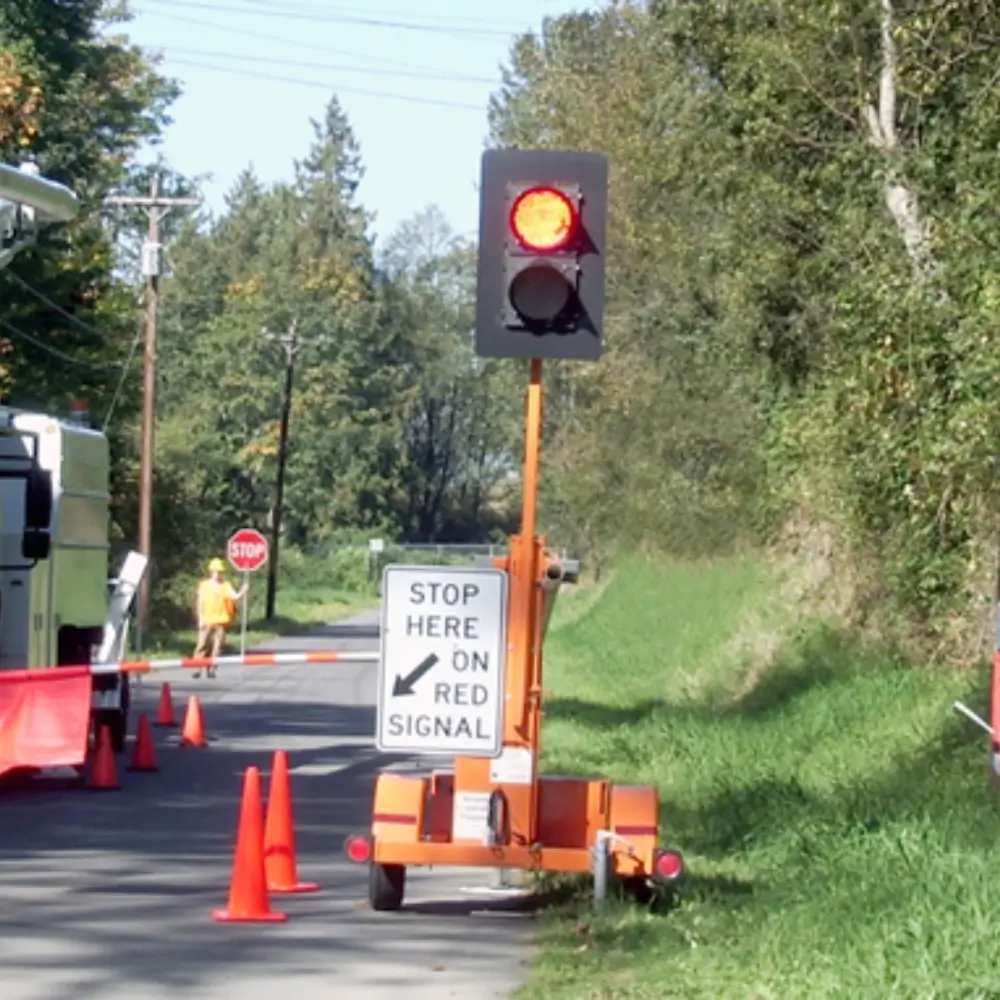
Temporary traffic signals are portable signaling systems used to control traffic flow in areas with altered traffic patterns. They mimic the functionality of permanent traffic lights but are designed for temporary deployment.
Usage
- Construction Zones: Manage traffic around ongoing roadworks or maintenance activities.
- Public Events: Control traffic during festivals, races, or large gatherings.
- Emergency Situations: Redirect traffic during accidents or natural disasters.
Benefits
- Rapid Deployment: Easily installed and removed as traffic conditions change.
- Cost-Effective: Less expensive than permanent installations, making them ideal for short-term needs.
- Versatility: Can be programmed to accommodate various traffic scenarios and timings.
Technical Features
Modern temporary traffic signals may include programmable controllers, LED displays for energy efficiency, and wireless connectivity for remote management.
17. Pedestrian Crosswalk Signs
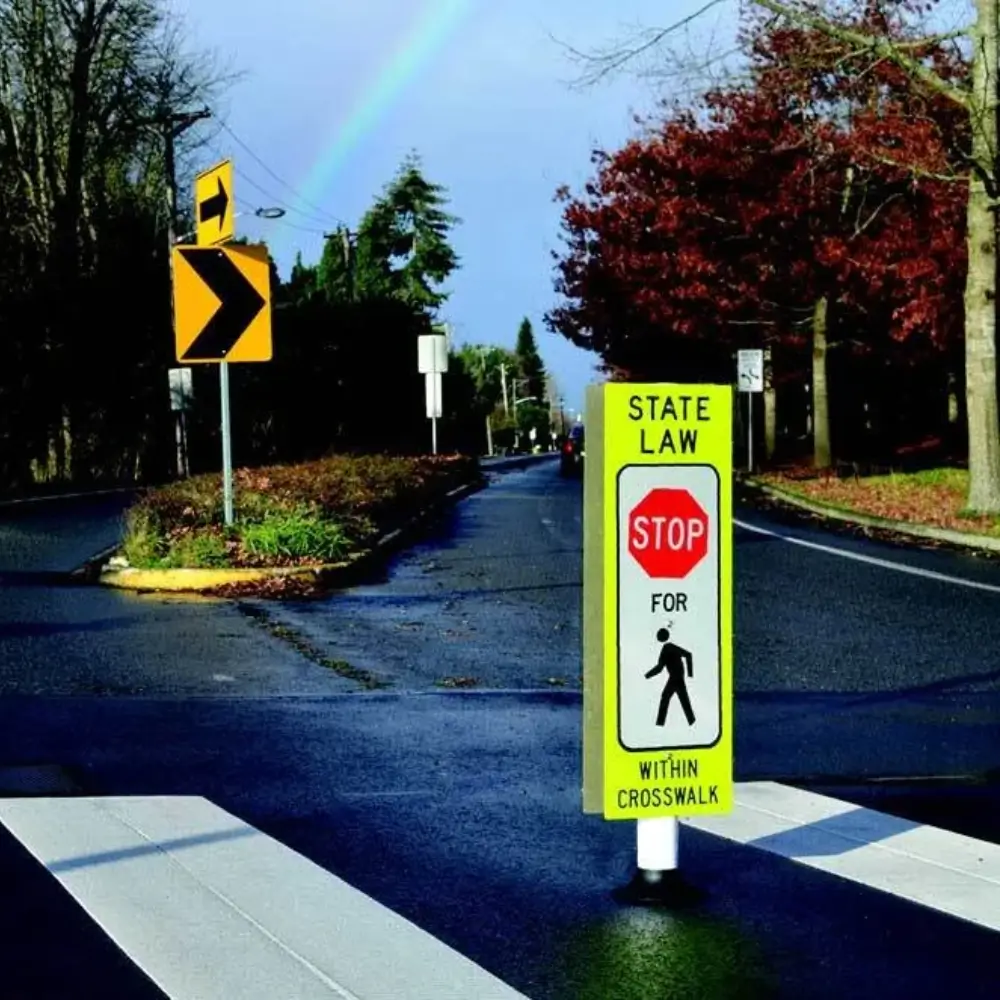
Pedestrian crosswalk signs are indicators placed at designated crossing points to alert drivers of pedestrian activity. They often feature symbols of walking individuals and may include flashing lights or signals.
Usage
- Intersections: Mark safe crossing points at busy intersections.
- School Zones: Enhance safety in areas with high pedestrian traffic, especially children.
- High-Footfall Areas: Installed near shopping centers, parks, and other popular pedestrian destinations.
Benefits
- Enhanced Pedestrian Safety: Clearly marks crossing areas, reducing the risk of accidents.
- Driver Awareness: Reminds drivers to yield to pedestrians, promoting courteous driving behavior.
- Compliance: Helps meet legal requirements for pedestrian safety in public spaces.
Design Standards
Crosswalk signs follow standardized designs to ensure recognizability and effectiveness, often incorporating reflective materials for nighttime visibility.
18. Speed Limit Signs

Speed limit signs indicate the maximum legal speed permitted for a specific section of road. They are standardized in design, featuring a white background with black numerals and borders.
Usage
- Highways and Freeways: Regulate speeds to ensure smooth and safe traffic flow.
- Residential Streets: Lower speed limits to protect pedestrians and reduce noise.
- School Zones: Temporarily reduce speed limits during school hours for added safety.
Benefits
- Traffic Regulation: Helps control vehicle speeds, reducing the likelihood of accidents.
- Legal Enforcement: Provides a clear legal framework for speed-related traffic laws.
- Consistency: Uniform design ensures drivers can quickly understand and comply with speed restrictions.
Technological Integrations
Some speed limit signs have digital displays, allowing for dynamic speed limit changes based on traffic conditions or environmental factors.
19. Work Zone Signs

Work zone signs are specialized traffic signs that inform drivers of construction or maintenance activities ahead. They often feature flashing lights or message boards to convey important information.
Usage
- Construction Sites: Alert drivers to lane closures, detours, and reduced speed limits.
- Maintenance Activities: Inform about road repairs, utility work, or other ongoing maintenance tasks.
- Event Preparations: Prepare drivers for temporary changes in traffic patterns due to events.
Benefits
- Driver Awareness: Keeps drivers informed about upcoming changes, promoting safer driving behavior.
- Flexibility: Can be updated with current information to reflect real-time work zone conditions.
- Safety Enhancement: Reduces the risk of accidents by clearly communicating hazards and changes.
Compliance and Standards
Work zone signs adhere to MUTCD guidelines, ensuring consistency in design and placement for maximum effectiveness.
20. Portable Message Boards

Portable message boards are electronic displays that provide variable messages to drivers. They can show information such as detours, road conditions, speed limits, and emergency alerts.
Usage
- Construction Zones: Communicate real-time updates about roadworks and traffic changes.
- Emergency Situations: Provide urgent information during accidents, natural disasters, or other emergencies.
- Special Events: Display messages related to event schedules, parking, and traffic routing.
Benefits
- Dynamic Communication: Easily update messages to reflect current conditions and needs.
- Enhanced Visibility: Bright, electronic displays are easily seen by drivers, even from a distance.
- Versatility: Can convey a wide range of messages, improving overall traffic management.
Technological Features
Modern portable message boards may include features like wireless connectivity for remote updates, programmable message sequences, and solar-powered options for energy efficiency.
21. Traffic Control Wands

Traffic control wands are handheld, illuminated devices traffic personnel use to direct vehicles. They often feature bright colors, reflective materials, and integrated lights for nighttime visibility.
Usage
- Flaggers: Guide traffic through construction zones, accidents, or special events.
- Crowd Control: Direct vehicles and pedestrians during large gatherings or emergencies.
- Temporary Traffic Management: Assist in managing traffic flow in areas without permanent signals.
Benefits
- High Visibility: Illuminated and brightly colored, making them easily noticeable to drivers.
- Portability: Lightweight and easy to carry, allowing for quick movement and direction changes.
- Effective Communication: Provides clear, non-verbal instructions to drivers, enhancing safety and efficiency.
Safety Standards
Operators should be trained in proper use to ensure effective communication and prevent misunderstandings on the road.
22. Safety Vests

Safety vests are high-visibility garments worn by workers to enhance their visibility to drivers. They are typically made from fluorescent materials with reflective strips.
Usage
- Construction Workers: Ensure workers are seen in active work zones.
- Roadside Assistance Personnel: Increase visibility during roadside emergencies or breakdowns.
- Event Staff: Make personnel easily identifiable during large gatherings or events.
Benefits
- Enhanced Visibility: High-contrast colors and reflective elements make wearers noticeable in various lighting conditions.
- Worker Safety: Reduces the risk of accidents by making workers visible to oncoming traffic.
- Compliance: Meets safety regulations for personal protective equipment in high-risk environments.
Standards and Certifications
Safety vests should comply with standards such as ANSI/ISEA 107 for high-visibility safety apparel, ensuring adequate visibility and durability.
23. Rumble Strips

When driven over, rumble strips are grooves or raised patterns placed on road surfaces that create noise and vibration. They are designed to alert inattentive drivers and prevent unintended lane departures.
Usage
- Highway Medians: Prevent cross-over accidents by signaling when a vehicle drifts into the opposite lane.
- Curves and Slopes: Warn drivers of upcoming changes in road geometry.
- Divided Highways: Enhance safety by providing tactile and auditory alerts for lane discipline.
Benefits
- Accident Prevention: Reduce the likelihood of run-off-road and head-on collisions.
- Driver Alertness: Capture driver attention, especially during long or monotonous drives.
- Cost-Effective: Provide a low-cost solution for enhancing road safety without significant infrastructure changes.
Design Considerations
Proper placement and depth are crucial to ensure effectiveness without causing excessive wear on vehicles or discomfort to drivers.
24. Temporary Railing Systems
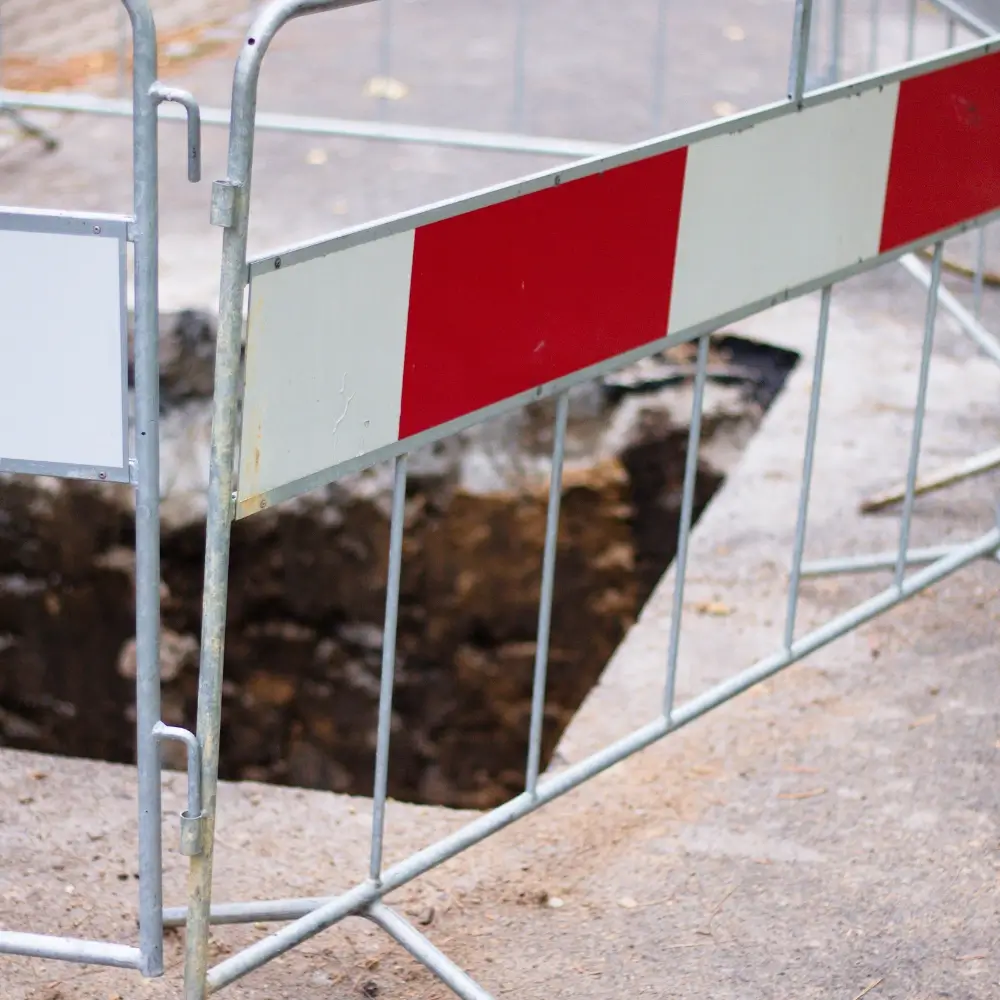
Temporary railing systems are barriers set up to protect workers and pedestrians near construction zones or other hazardous areas. They are often made from steel or heavy-duty plastic and can be configured in various layouts.
Usage
- Construction Sites: Segregate active work areas from public spaces.
- Event Setups: Create safe zones around stages, equipment, or other temporary structures.
- Emergency Responses: Secure areas during rescue operations or disaster relief efforts.
Benefits
- Safety Assurance: Prevent unauthorized access to dangerous areas, reducing the risk of accidents.
- Flexibility: Easily assembled, reconfigured, and disassembled to suit changing needs.
- Durability: Designed to withstand impacts and harsh environmental conditions.
Installation Best Practices
Ensuring secure anchoring and appropriate spacing between railings is essential for maximum effectiveness and safety.
25. Emergency Flares

Emergency flares are pyrotechnic devices that signal hazards or guide traffic during emergencies. They emit bright light and intense heat, making them highly visible even in adverse conditions.
Usage
- Roadside Emergencies: Mark disabled vehicles or accident sites to alert oncoming traffic.
- Natural Disasters: Guide evacuation routes or highlight safe zones.
- Search and Rescue: Illuminate areas for rescue teams during nighttime operations.
Benefits
- High Visibility: Provide immediate and noticeable alerts to drivers and rescue personnel.
- Ease of Use: Simple to deploy and effective without the need for external power sources.
- Versatility: Applicable in various emergency scenarios, enhancing overall safety.
Safety Precautions
Proper handling and storage are crucial to prevent accidental ignition and ensure safe usage during emergencies.
Conclusion
Traffic safety equipment encompasses various tools and devices, each meticulously designed to address specific aspects of road safety and traffic management. From the ubiquitous traffic cones that guide drivers around construction zones to the sophisticated crash cushions that absorb impact energy during collisions, these equipment types work in unison to create safer road environments for everyone involved—drivers, pedestrians, and workers alike.
Understanding the functionalities, applications, and benefits of each type of traffic safety equipment is essential for effective implementation and maintenance. As transportation systems evolve, so will the technologies and methodologies employed to ensure road safety. Staying informed and adhering to best practices can significantly reduce traffic-related incidents and foster a culture of safety on our roads.
References:
- National Highway Traffic Safety Administration (NHTSA)
- Federal Highway Administration (FHWA)
- Manual on Uniform Traffic Control Devices (MUTCD)
- American Association of State Highway and Transportation Officials (AASHTO)
- Occupational Safety and Health Administration (OSHA) Traffic Control Guidelines
This article is regularly updated to reflect the latest standards and innovations in traffic safety equipment. For detailed information on each equipment type, consult the provided references or contact local traffic management authorities.

